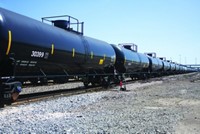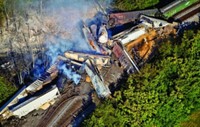Advertisement
Grab your lab coat. Let's get started
Welcome!
Welcome!
Create an account below to get 6 C&EN articles per month, receive newsletters and more - all free.
It seems this is your first time logging in online. Please enter the following information to continue.
As an ACS member you automatically get access to this site. All we need is few more details to create your reading experience.
Not you? Sign in with a different account.
Not you? Sign in with a different account.
ERROR 1
ERROR 1
ERROR 2
ERROR 2
ERROR 2
ERROR 2
ERROR 2
Password and Confirm password must match.
If you have an ACS member number, please enter it here so we can link this account to your membership. (optional)
ERROR 2
ACS values your privacy. By submitting your information, you are gaining access to C&EN and subscribing to our weekly newsletter. We use the information you provide to make your reading experience better, and we will never sell your data to third party members.
Policy
Chlorine Transportation
July 26, 2010
| A version of this story appeared in
Volume 88, Issue 30
In the article “Chlorine Shippers Fear Rail Rate Hikes,” railroads make it clear that they intend to make chlorine shippers pay for an upgrade in rail safety and efficiency (C&EN, June 28, page 36). When considering all the business benefits of this upgrade, targeted rate hikes would be unwarranted and unfair.
Chlorine producers have long worked proactively and cooperatively with government officials to strengthen safety and security measures at our chemical facilities. We understand the tremendous responsibility we have to keep our communities and employees safe. Over the past nine years, the chemical industry has invested more than $8 billion on facility security and transportation enhancements. We continue to work with railroads, lawmakers, and regulators to improve upon an already strong safety record, including developing even safer railcars for transporting chlorine.
As part of this commitment, we fully support Congress’ decision to require railroads to enact safety measures of their own known as Positive Train Control (PTC). However, PTC does more than improve safety. An analysis by the Federal Railroad Administration found that PTC would result in increased line capacity, fuel savings, improved rail dispatching operations, and societal benefits from reduced highway accidents and reduced emissions. According to one analysis, the total benefits of PTC would exceed $17 billion. That analysis includes billions of dollars in direct business benefits for railroads.
So it’s puzzling that the railroads now refuse to acknowledge these benefits. Citing an incomplete cost-benefit analysis that only considers the safety benefits of PTC, railroads are building a case for charging chlorine and other toxic inhalation hazard (TIH) shippers an even greater premium to recoup their investment in PTC. We understand that rates should in part reflect risk. That’s why railroads already charge TIH shippers more than shippers of other products. But it’s clear that PTC will lower the risk of shipping chlorine while lowering costs for the railroads at the same time. It also stands to reason that liability insurance for railroads would reflect the reduced risk of transporting any materials, including TIH shipments, along rail lines that receive PTC safety upgrades.
Families depend on railroads to transport chlorine so they can have safe drinking water. Renewable energy companies depend on the safe transport of chlorine so they can ultimately produce solar cells. A flawed financial analysis of these long-overdue safety enhancements should not be used as an excuse to pad the railroads’ bottom line at the expense of TIH shippers.
Frank Reiner
President, The Chlorine Institute
Arlington, Va.




Join the conversation
Contact the reporter
Submit a Letter to the Editor for publication
Engage with us on Twitter